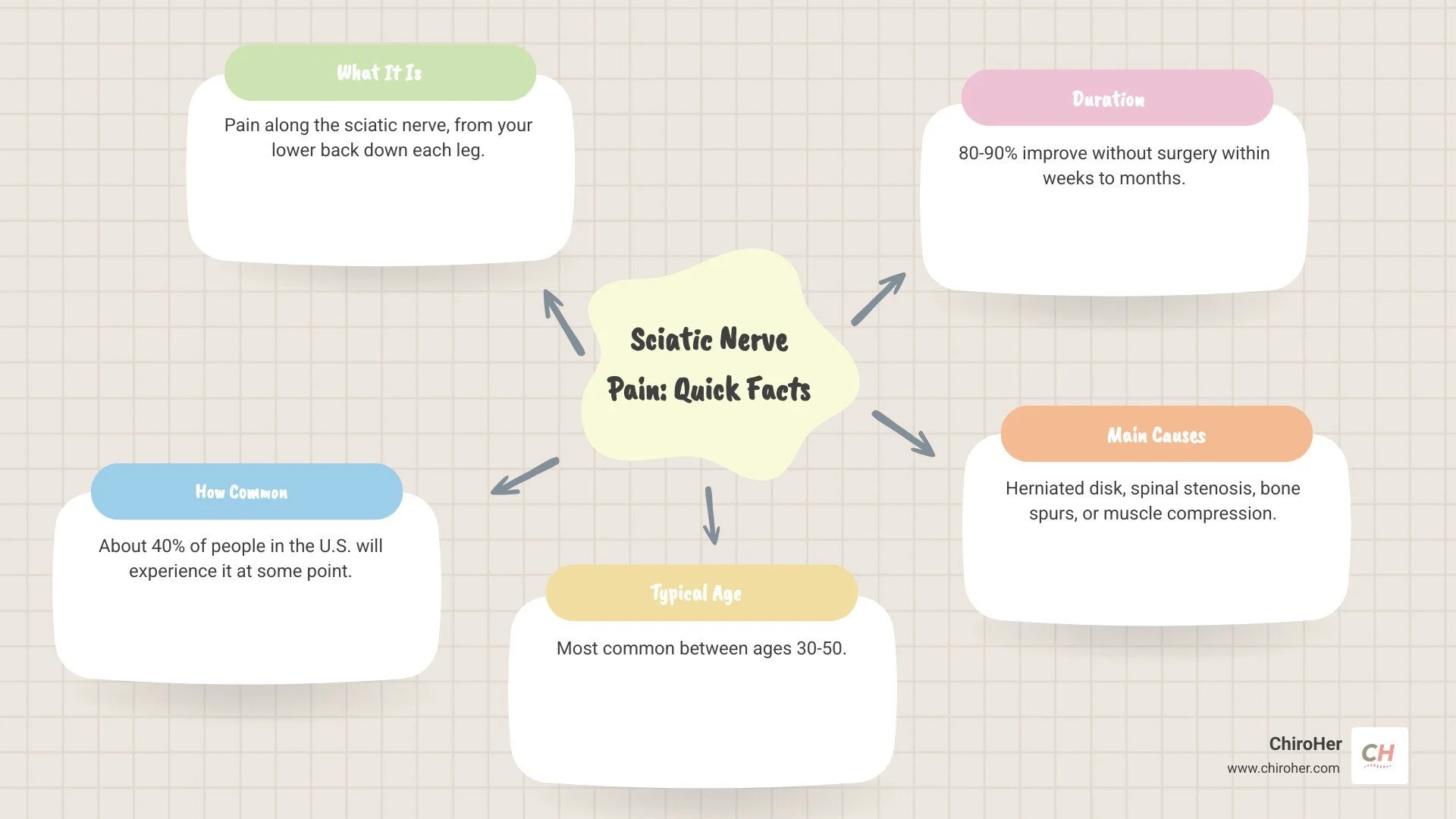Zap! Understanding and Treating Sciatic Nerve Pain
When Sharp Pain Shoots Down Your Leg
Sciatic nerve pain is a sharp, shooting sensation that travels from your lower back down your leg. It's not a disease, but a symptom of an underlying issue compressing the sciatic nerve, the longest nerve in your body. This irritation can cause an electric shock, burning, or pins and needles, making simple activities painful.
Quick Facts About Sciatic Nerve Pain:
What it is: Pain along the sciatic nerve, which runs from your lower back down each leg.
How common: About 40% of people in the U.S. will experience it.
Typical age range: Most common between ages 30-50.
Duration: 80-90% of cases improve without surgery within weeks to months.
Main causes: Herniated disk, spinal stenosis, bone spurs, or muscle compression.
The good news is that most people with sciatica get better without surgery. The key is understanding the cause and taking the right steps to address it.
Hello, I'm Dr. Michelle Andrews, founder of ChiroHer in Oklahoma City. I've helped hundreds of patients, including expecting mothers and busy professionals, find relief from sciatic nerve pain through personalized chiropractic care.
What is Sciatica and What Does It Feel Like?
The sciatic nerve is a large bundle of nerves from the lower spine that runs down each leg. When this nerve is irritated, pinched, or compressed, it causes sciatic nerve pain, also known as lumbar radiculopathy.
The pain is distinctive, typically starting in the lower back or buttock and radiating down one leg, sometimes to the foot. While it usually affects one side, in rare cases, it can occur in both legs. This unilateral nature helps distinguish it from general low back pain.
Patients describe sciatica in various ways:
A mild, constant ache
A sharp, burning sensation
A sudden jolt or electric shock
Numbness or tingling ("pins and needles")
Muscle weakness in the leg or foot
Sciatica is a symptom, not a diagnosis. It signals that something is irritating your sciatic nerve, and our job at ChiroHer is to find and treat that underlying issue.
Common Causes and Risk Factors
Sciatica is a sign that something is putting pressure on the sciatic nerve. Here are the most common culprits:
Herniated Disk: This is the most frequent cause. The soft inner material of a spinal disk bulges out and presses on a sciatic nerve root.
Spinal Stenosis: A narrowing of the spinal canal that can put pressure on the spinal cord and nerve roots.
Bone Spurs: Overgrowths of bone on the vertebrae that can impinge on nerve roots.
Piriformis Syndrome: A tight or spasming piriformis muscle in the buttock can compress the sciatic nerve.
Spondylolisthesis: This occurs when one vertebra slips forward over another, pinching nerve roots.
Injuries: Direct trauma to the lower back or pelvis can lead to sciatic nerve pain.
Certain factors increase your risk:
Age: It's most common between 30 and 50, as age-related changes in the spine increase.
Obesity: Excess weight puts more stress on your spine.
Occupation: Jobs requiring heavy lifting, twisting, or prolonged sitting increase risk.
Prolonged Sitting: A sedentary lifestyle can put pressure on the lower spine.
Diabetes: This condition increases the risk of nerve damage.
Pregnancy: Hormonal changes and pressure from the growing uterus can affect the sciatic nerve. We specialize in helping expectant mothers in Nichols Hills and Del City manage this discomfort. You can learn more about how we support mothers-to-be on our pregnancy and sciatica nerve page.
For more information on the medical causes and risk factors, we recommend reputable sources like the Mayo Clinic's explanation of sciatica.
Recognizing the Symptoms of Sciatic Nerve Pain
Recognizing sciatica's specific symptoms is key to getting the right care. Look for this distinct pattern:
Radiating Pain: This is the hallmark symptom. Pain travels from the lower back or buttock down the back of one leg.
Sharp Pain or Burning Sensation: Many describe the pain as sharp or searing rather than a dull ache.
Electric Shock-like Sensation: Sudden, intense jolts of pain can occur, especially with movement.
Numbness: A loss of sensation can occur anywhere along the nerve's path.
Tingling ("Pins and Needles"): A prickly or buzzing feeling, similar to a limb "falling asleep."
Muscle Weakness: More severe cases can cause weakness in the leg or foot, making it hard to lift your foot ("foot drop").
Pain Worsens with Certain Activities: Sitting for long periods, coughing, or sneezing can increase pain, while standing or lying down may provide relief.
The intensity of symptoms varies. We've compiled more detailed information about sciatic pain location to help you pinpoint exactly where your discomfort is coming from.
Your Guide to Managing Sciatic Nerve Pain
If you're dealing with sciatic nerve pain, I know it can be challenging. But for most people, relief is within reach. Our approach at ChiroHer is to find and address the root cause of your pain with a personalized plan.
How Sciatica is Diagnosed
An accurate diagnosis is the first step. We need to identify what's irritating your sciatic nerve.
When you visit our Oklahoma City clinic, we start with a thorough medical history to understand your symptoms and daily activities. This is followed by a physical exam where we check your reflexes, muscle strength, and sensation. We'll also perform a straight leg raise test, a reliable indicator of sciatic nerve irritation.
For many, these assessments are enough to begin treatment. Sometimes, we need a clearer picture and may recommend imaging tests. An X-ray can show bone spurs or alignment issues, while an MRI is excellent for identifying herniated disks. In some cases, an EMG may be used to measure nerve function, especially if we suspect a trapped nerve in your lower back.
Self-Care and Chiropractic Approaches for Sciatic Nerve Pain
The encouraging truth is that 80-90% of people with sciatica improve without surgery. Conservative treatments and self-care are highly effective. At ChiroHer, we empower our patients in Oklahoma City, Yukon, and Moore with practical strategies and targeted chiropractic care.
Here's what you can do at home:
Heat and Cold Therapy: Use cold packs for the first few days to reduce inflammation, then switch to a heating pad to relax muscles.
Gentle Movement: Avoid prolonged bed rest. Short walks and light stretching prevent stiffness and promote healing.
Over-the-Counter Pain Relievers: Ibuprofen or naproxen can help manage pain and inflammation.
Safe Activity Guidance: We'll teach you proper lifting techniques and how to modify daily routines to avoid aggravating the nerve.
Chiropractic care addresses the source of the problem:
Spinal Adjustments: Gentle, precise movements restore spinal alignment, relieving pressure on the sciatic nerve.
Therapeutic Exercises: We guide you through targeted stretches and strengthening exercises for your core. You can find examples on our sciatica exercises page.
Manual Therapy: These techniques release muscle tension and improve joint mobility.
Holistic Wellness: We also offer acupuncture and electrical muscle stimulation to reduce pain and muscle spasms.
Surgery is rarely needed and is only considered for severe, persistent symptoms. Our team can help you understand all your options. Learn more about how a chiropractor can help with sciatica and what to expect from treatment.
Living with Sciatica: Outlook and Daily Management
Living with sciatic nerve pain can be frustrating, but the outlook for most people is positive. There are practical ways to manage its impact on your life.
The long-term outlook is encouraging, with 80-90% of people improving within weeks to months without surgery. However, sciatica can disrupt your daily routine, making sitting, standing, or even sleeping difficult. With proper treatment and management strategies, you can take back control.
While uncommon, potential complications from unmanaged sciatica can include chronic pain or permanent nerve damage. In very rare cases, severe nerve compression can affect bowel or bladder function, which is a medical emergency.
Preventing Sciatica and Reducing Recurrence
While not all causes of sciatica are preventable, you can control many risk factors to keep your spine healthy.
Regular Exercise: Low-impact activities like walking or swimming promote good circulation and keep your spine healthy.
Core Strength: Strong abdominal and back muscles provide natural support for your lower back.
Proper Posture: When sitting, keep your feet flat on the floor with your knees level with your hips. Use a small pillow for lower back support if needed. We have more information on correct posture exercises.
Lifting Techniques: Always lift with your legs, not your back. Keep your back straight and avoid twisting while lifting.
Maintain a Healthy Weight: Reducing excess weight, especially around your midsection, lessens the stress on your spine.
Quit Tobacco: Nicotine impairs blood flow to your spinal disks, accelerating degeneration.
Protect Against Falls: Prevent injuries by ensuring your home is safe and wearing appropriate footwear.
When to Seek Professional Help
Most sciatica improves with self-care, but some symptoms require professional help.
Seek immediate medical attention if you experience:
Loss of bladder or bowel control (a sign of cauda equina syndrome).
Sudden, severe weakness or numbness in your leg or groin.
Symptoms that appear after a major injury, like a car accident.
Severe pain that prevents you from moving.
You should also schedule a consultation if your pain:
Worsens despite self-care.
Lasts longer than a week or two.
Interferes with your daily activities.
Returns after a period of improvement.
At ChiroHer, we offer holistic approaches customized to your needs. Our team is dedicated to helping you find lasting relief. Don't let sciatic nerve pain limit your life—schedule a consultation for your low back and sciatic pain with us today.
Building Trust: Authority and Resources
Hello, I'm Dr. Michelle Andrews, founder of ChiroHer in Oklahoma City. I've dedicated my career to helping people find relief from sciatic nerve pain through evidence-based chiropractic care. Our team provides personalized, holistic treatment that addresses the root cause of your discomfort.
At ChiroHer, we believe in empowering our patients with knowledge. We encourage you to explore reputable medical resources to deepen your understanding of sciatic nerve pain. For additional information, we recommend consulting trusted sources like the Mayo Clinic's detailed overview of sciatica and the National Institutes of Health's patient information on sciatica.
Our approach combines years of clinical experience with ongoing education. We've helped hundreds of patients throughout Oklahoma City, Edmond, and Yukon find lasting relief. We understand that choosing a healthcare provider is a significant decision. Our boutique setting provides a comfortable, welcoming environment where your treatment is customized to your needs.
This article is for informational purposes only and does not constitute medical advice. The information contained herein is not intended to diagnose, treat, cure, or prevent any disease. Please consult with a licensed healthcare professional for any health concerns.




